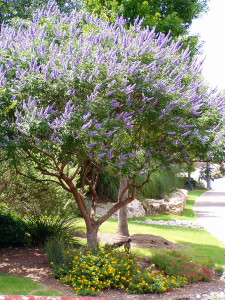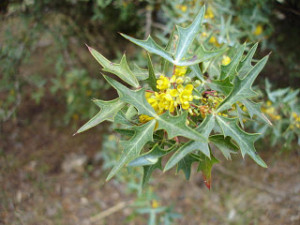by Sheryl Kleinschmidt, Somervell County Master Gardener
 Mother Nature has surprised me once again. Just when I think I’ve seen it all, she displays another species right under my nose and sticks out her tongue to say, “Nanny-nanny boo-boo— look what I can do!”
Mother Nature has surprised me once again. Just when I think I’ve seen it all, she displays another species right under my nose and sticks out her tongue to say, “Nanny-nanny boo-boo— look what I can do!”
This time it was the wild clematis. I discovered it growing on the old barn behind my house about a week ago as I walked up the driveway to my truck. Thinking I was seeing things, I quickly walked closer to observe an abundance of creamy-white blossoms trailing down from a height of about 15 feet.
Having lived in the same location for six years, this is the first time I’ve seen the clematis in bloom and assume the seeds either blew in or were dropped by birds last year. I took a small cutting to a very knowledgeable neighbor who identified it for me and I began researching the plant. It was confusing at first due to the large number of varieties—some wild, some not (there are hundreds).
After close examination, I discovered that the variety growing behind my house is the Clematis vitalba. It is described as a fast-growing woody vine that can climb up to 30’ (sometimes taller) and has an undetermined amount of ground spread.
The wild clematis is known by many common names such as Old Man’s Beard, Traveler’s Joy, Devil’s Darning Needle, Virgin’s Bower and Woodbine. Its bright green leaves make a great backdrop for large masses of white flowers which bloom late summer to autumn. It is an import from Europe and southwestern Asia — not native to America. Maybe that accounts for it not being affected by many pests here.
Once done flowering, the lingering style remains with long, silky hairs trailing down on all sides—thus the name Old Man’s Beard. When dried, the seeds are propagated by wind and animals, much like milkweed is spread.
The wild clematis is a very adaptable plant and is viable in Zones 4-8. It will grow in shade or sun but does prefer afternoon shade. It will tolerate most soil types and can do quite well in drought situations. However, given the opportunity and lots of moisture, it will “go to town”.
Some of our northwestern states (Washington, Oregon) consider the wild clematis to be an invasive plant as their cooler, wetter climate is conducive to vigorous growth. There, it has been seen to grow as tall as 100 feet into the treetops smothering many old-growth native trees. It is also prolific under bridges, in wood margins and hedgerows. Actually, it has become such a nuisance that the nurseries no longer keep it in stock as a garden plant.
The vines behind my house are welcome, however, and have a wonderful, sweet scent that attracts bees, butterflies and hummingbirds. As a matter of fact, I intend to take some cuttings and will watch in anticipation of the bearded seeds this fall.
Until then, I’ll just enjoy the view…………





